Marketing Environment Analysis for Otago Polytechnic
VerifiedAdded on 2023/01/18
|12
|3051
|30
AI Summary
This paper analyzes the marketing environment for Otago Polytechnic, including micro-environmental and macro-environmental factors. It also includes a SWOT analysis and recommendations for the organization.
Contribute Materials
Your contribution can guide someone’s learning journey. Share your
documents today.
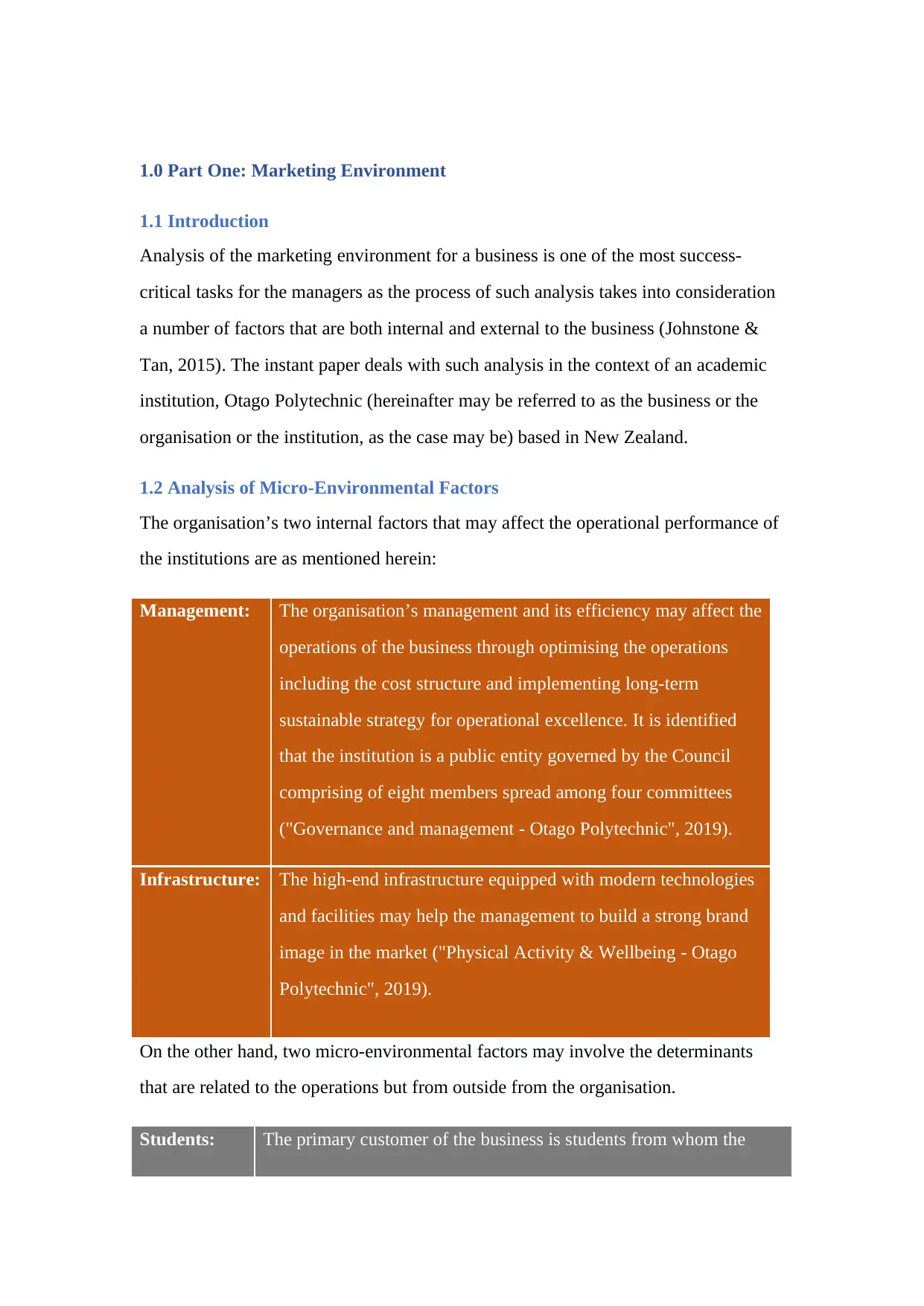
1.0 Part One: Marketing Environment
1.1 Introduction
Analysis of the marketing environment for a business is one of the most success-
critical tasks for the managers as the process of such analysis takes into consideration
a number of factors that are both internal and external to the business (Johnstone &
Tan, 2015). The instant paper deals with such analysis in the context of an academic
institution, Otago Polytechnic (hereinafter may be referred to as the business or the
organisation or the institution, as the case may be) based in New Zealand.
1.2 Analysis of Micro-Environmental Factors
The organisation’s two internal factors that may affect the operational performance of
the institutions are as mentioned herein:
Management: The organisation’s management and its efficiency may affect the
operations of the business through optimising the operations
including the cost structure and implementing long-term
sustainable strategy for operational excellence. It is identified
that the institution is a public entity governed by the Council
comprising of eight members spread among four committees
("Governance and management - Otago Polytechnic", 2019).
Infrastructure: The high-end infrastructure equipped with modern technologies
and facilities may help the management to build a strong brand
image in the market ("Physical Activity & Wellbeing - Otago
Polytechnic", 2019).
On the other hand, two micro-environmental factors may involve the determinants
that are related to the operations but from outside from the organisation.
Students: The primary customer of the business is students from whom the
1.1 Introduction
Analysis of the marketing environment for a business is one of the most success-
critical tasks for the managers as the process of such analysis takes into consideration
a number of factors that are both internal and external to the business (Johnstone &
Tan, 2015). The instant paper deals with such analysis in the context of an academic
institution, Otago Polytechnic (hereinafter may be referred to as the business or the
organisation or the institution, as the case may be) based in New Zealand.
1.2 Analysis of Micro-Environmental Factors
The organisation’s two internal factors that may affect the operational performance of
the institutions are as mentioned herein:
Management: The organisation’s management and its efficiency may affect the
operations of the business through optimising the operations
including the cost structure and implementing long-term
sustainable strategy for operational excellence. It is identified
that the institution is a public entity governed by the Council
comprising of eight members spread among four committees
("Governance and management - Otago Polytechnic", 2019).
Infrastructure: The high-end infrastructure equipped with modern technologies
and facilities may help the management to build a strong brand
image in the market ("Physical Activity & Wellbeing - Otago
Polytechnic", 2019).
On the other hand, two micro-environmental factors may involve the determinants
that are related to the operations but from outside from the organisation.
Students: The primary customer of the business is students from whom the
Secure Best Marks with AI Grader
Need help grading? Try our AI Grader for instant feedback on your assignments.
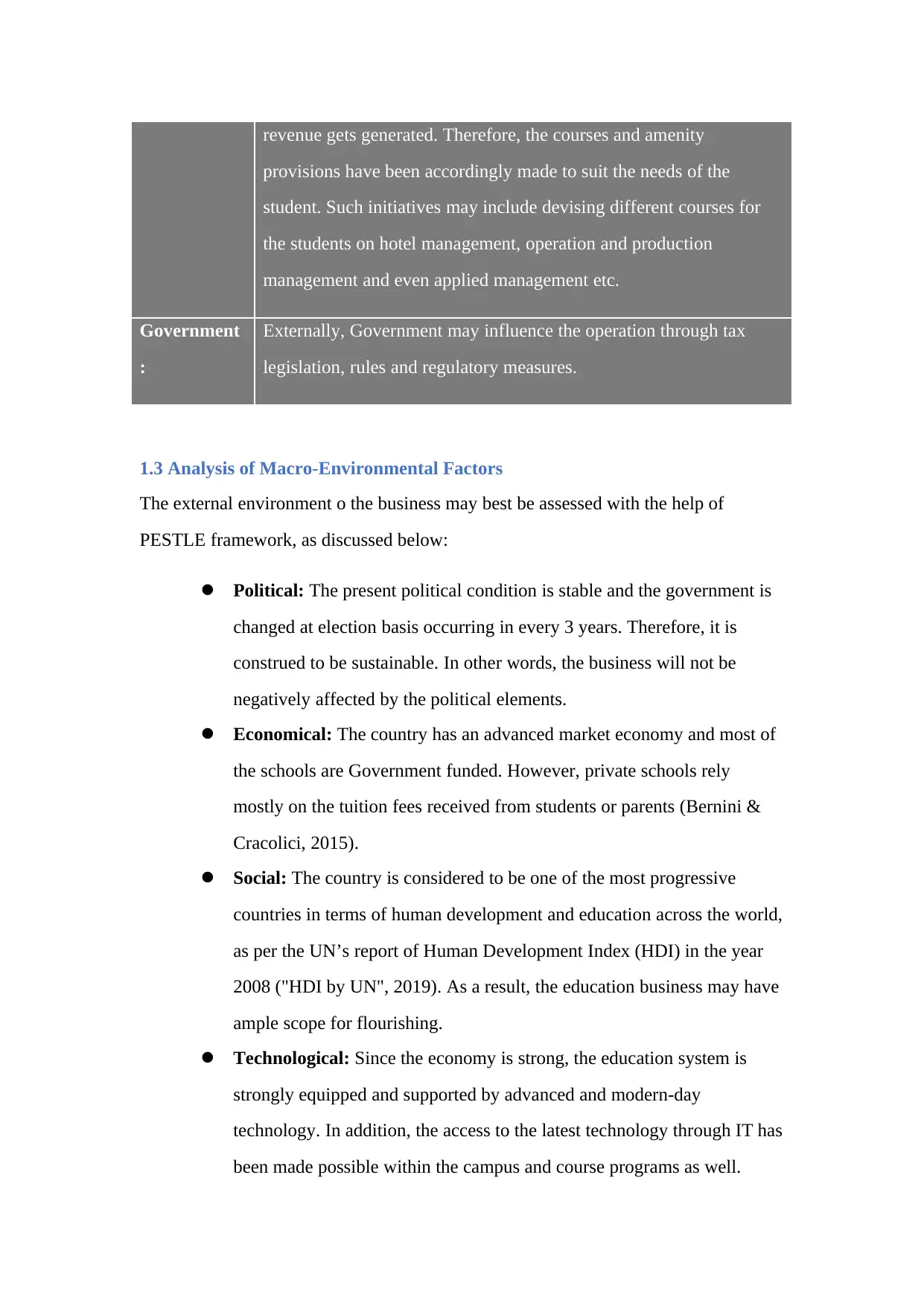
revenue gets generated. Therefore, the courses and amenity
provisions have been accordingly made to suit the needs of the
student. Such initiatives may include devising different courses for
the students on hotel management, operation and production
management and even applied management etc.
Government
:
Externally, Government may influence the operation through tax
legislation, rules and regulatory measures.
1.3 Analysis of Macro-Environmental Factors
The external environment o the business may best be assessed with the help of
PESTLE framework, as discussed below:
Political: The present political condition is stable and the government is
changed at election basis occurring in every 3 years. Therefore, it is
construed to be sustainable. In other words, the business will not be
negatively affected by the political elements.
Economical: The country has an advanced market economy and most of
the schools are Government funded. However, private schools rely
mostly on the tuition fees received from students or parents (Bernini &
Cracolici, 2015).
Social: The country is considered to be one of the most progressive
countries in terms of human development and education across the world,
as per the UN’s report of Human Development Index (HDI) in the year
2008 ("HDI by UN", 2019). As a result, the education business may have
ample scope for flourishing.
Technological: Since the economy is strong, the education system is
strongly equipped and supported by advanced and modern-day
technology. In addition, the access to the latest technology through IT has
been made possible within the campus and course programs as well.
provisions have been accordingly made to suit the needs of the
student. Such initiatives may include devising different courses for
the students on hotel management, operation and production
management and even applied management etc.
Government
:
Externally, Government may influence the operation through tax
legislation, rules and regulatory measures.
1.3 Analysis of Macro-Environmental Factors
The external environment o the business may best be assessed with the help of
PESTLE framework, as discussed below:
Political: The present political condition is stable and the government is
changed at election basis occurring in every 3 years. Therefore, it is
construed to be sustainable. In other words, the business will not be
negatively affected by the political elements.
Economical: The country has an advanced market economy and most of
the schools are Government funded. However, private schools rely
mostly on the tuition fees received from students or parents (Bernini &
Cracolici, 2015).
Social: The country is considered to be one of the most progressive
countries in terms of human development and education across the world,
as per the UN’s report of Human Development Index (HDI) in the year
2008 ("HDI by UN", 2019). As a result, the education business may have
ample scope for flourishing.
Technological: Since the economy is strong, the education system is
strongly equipped and supported by advanced and modern-day
technology. In addition, the access to the latest technology through IT has
been made possible within the campus and course programs as well.

Legal: Opening an educational institute is very easy in the country as
there is a three-tier education system post which the students may pursue
higher studies based on their individual carer decisions and choice.
Moreover, the legal binding is lenient ("How to Start a Business | Invest
in New Zealand | NZ Now", 2019). Therefore, the educational set-up
does not need stringent regulatory stipulations to abide by.
Environmental: Polytechnic college may not be subjected to stricter
environmental law; however, the management may need to control the
facility to ensure that the same will not cause any harm to the society in
terms of wastes disposal and air and water pollution. If the environmental
aspect has not been looked into with the importance, the same may cause
environmental pollution which, in turn, may adversity affect the
surrounding and thereby the brand name of the institute in the long-run.
1.4 SWOT Analysis of the Organisation
Strength
Strong brand name
Well educated country and
therefore the scope for further
expansion of the institute by
opening branch etc.
Strong employee and staff
satisfaction index
Weakness
Considerable carbon emission
The decreasing surplus for the
institution and risky financial
position("2017 Annual Report",
2019)
Opportunity
Scope for diversification in other
unexplored educational sectors
like technical education, adult
education, crèche facility and
child education etc.
Threat
Financial pressure on the capital
structure ("2017 Annual Report",
2019)
High dependence on the debt
burden as reflected in the annual
there is a three-tier education system post which the students may pursue
higher studies based on their individual carer decisions and choice.
Moreover, the legal binding is lenient ("How to Start a Business | Invest
in New Zealand | NZ Now", 2019). Therefore, the educational set-up
does not need stringent regulatory stipulations to abide by.
Environmental: Polytechnic college may not be subjected to stricter
environmental law; however, the management may need to control the
facility to ensure that the same will not cause any harm to the society in
terms of wastes disposal and air and water pollution. If the environmental
aspect has not been looked into with the importance, the same may cause
environmental pollution which, in turn, may adversity affect the
surrounding and thereby the brand name of the institute in the long-run.
1.4 SWOT Analysis of the Organisation
Strength
Strong brand name
Well educated country and
therefore the scope for further
expansion of the institute by
opening branch etc.
Strong employee and staff
satisfaction index
Weakness
Considerable carbon emission
The decreasing surplus for the
institution and risky financial
position("2017 Annual Report",
2019)
Opportunity
Scope for diversification in other
unexplored educational sectors
like technical education, adult
education, crèche facility and
child education etc.
Threat
Financial pressure on the capital
structure ("2017 Annual Report",
2019)
High dependence on the debt
burden as reflected in the annual

Growth in cash flow from
operations
report of the organisation ("2017
Annual Report", 2019)
1.5 Ethical and Social Responsibility of the Organisation
The educational set up must abide by its ethical framework in terms of fee-charging,
transparency in the operation and training and shareholder communication through
corporate reporting on a timely manner (Pudaruth & Nursing, 2017). Besides, the
environmental responsibility will include the consideration for GHG emission, carbon
usage, air and water pollution control measures etc. It is needless to mention that these
initiatives will considerably add value to the brand image of the organisation, which
in turn will help the institute to create a market of loyal and long-lasting customers.
OPIAC executes such responsibility by preparation of annual report on a timely
manner and ensuring the corporate reporting with detailed information in order to
manage the stakeholders’ expectation. Also, the sustainability reporting framework of
the organisation helps the stakeholders and society at large to assess the
environmental policies of the institution in countering the GHG emission and carbon
usage. The sustainability reporting framework has been well-explained within the
annual report of the organisation which clearly shows not only the ethical but also the
social responsibility of the business towards the community at large.
1.6 Recommendation
The management may need to consider opening a few technical courses not included
in the current curriculum in order to promote entrepreneurship. Sustainability may be
achieved if an educational house can create entrepreneurs. Besides, the debt should be
paid off gradually in order to nullify the negative impact of interest cost on the bottom
line. Moreover, the cash flow should be retained and used in future for the purpose of
expansion and marketing budget (Ganiyu, 2017).
1.7 Conclusion
Based on the discussion performed herein, it may be concluded that the well-designed
marketing strategy may significantly help an organisation to attain its pre-determined
operations
report of the organisation ("2017
Annual Report", 2019)
1.5 Ethical and Social Responsibility of the Organisation
The educational set up must abide by its ethical framework in terms of fee-charging,
transparency in the operation and training and shareholder communication through
corporate reporting on a timely manner (Pudaruth & Nursing, 2017). Besides, the
environmental responsibility will include the consideration for GHG emission, carbon
usage, air and water pollution control measures etc. It is needless to mention that these
initiatives will considerably add value to the brand image of the organisation, which
in turn will help the institute to create a market of loyal and long-lasting customers.
OPIAC executes such responsibility by preparation of annual report on a timely
manner and ensuring the corporate reporting with detailed information in order to
manage the stakeholders’ expectation. Also, the sustainability reporting framework of
the organisation helps the stakeholders and society at large to assess the
environmental policies of the institution in countering the GHG emission and carbon
usage. The sustainability reporting framework has been well-explained within the
annual report of the organisation which clearly shows not only the ethical but also the
social responsibility of the business towards the community at large.
1.6 Recommendation
The management may need to consider opening a few technical courses not included
in the current curriculum in order to promote entrepreneurship. Sustainability may be
achieved if an educational house can create entrepreneurs. Besides, the debt should be
paid off gradually in order to nullify the negative impact of interest cost on the bottom
line. Moreover, the cash flow should be retained and used in future for the purpose of
expansion and marketing budget (Ganiyu, 2017).
1.7 Conclusion
Based on the discussion performed herein, it may be concluded that the well-designed
marketing strategy may significantly help an organisation to attain its pre-determined
Secure Best Marks with AI Grader
Need help grading? Try our AI Grader for instant feedback on your assignments.
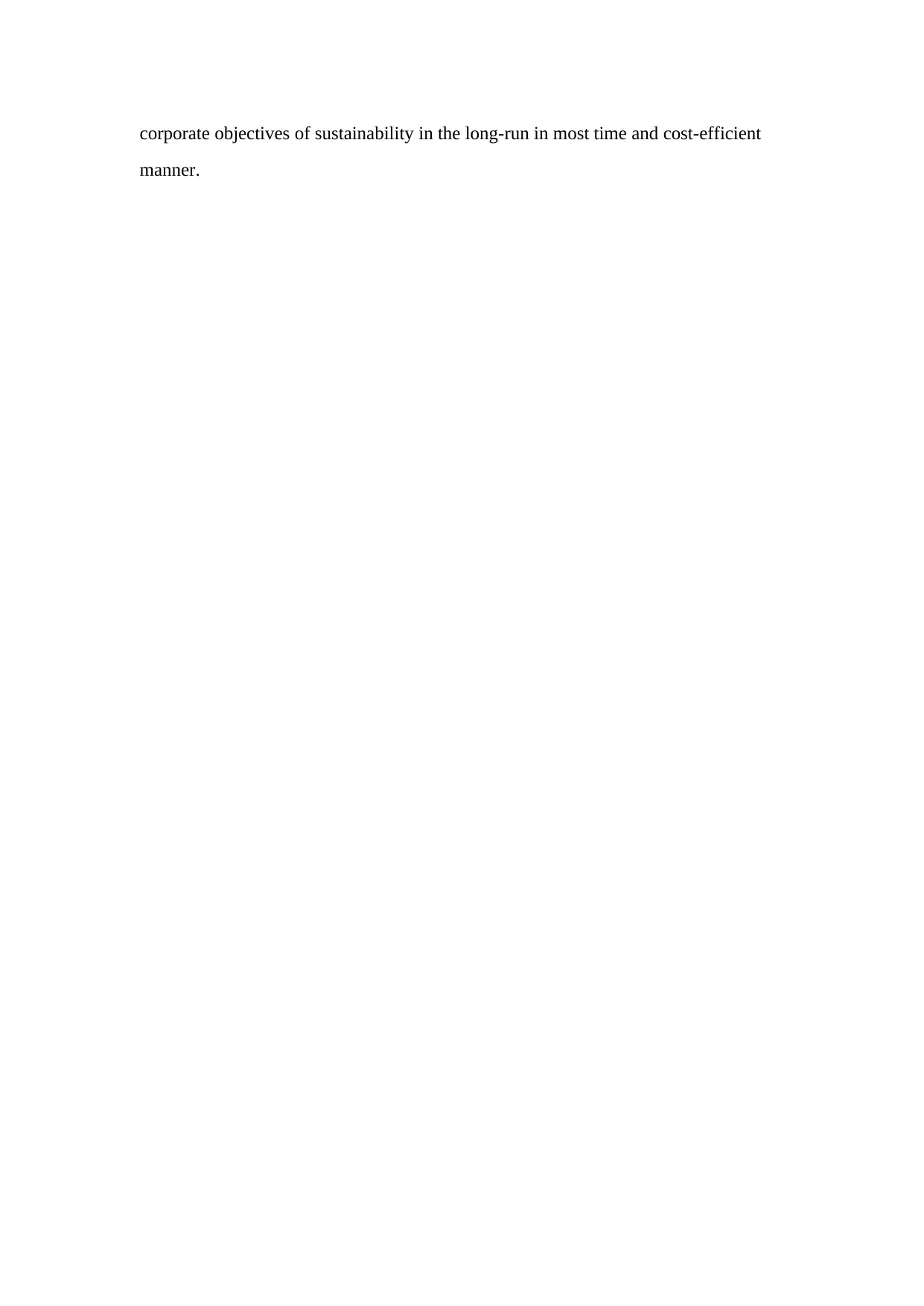
corporate objectives of sustainability in the long-run in most time and cost-efficient
manner.
manner.
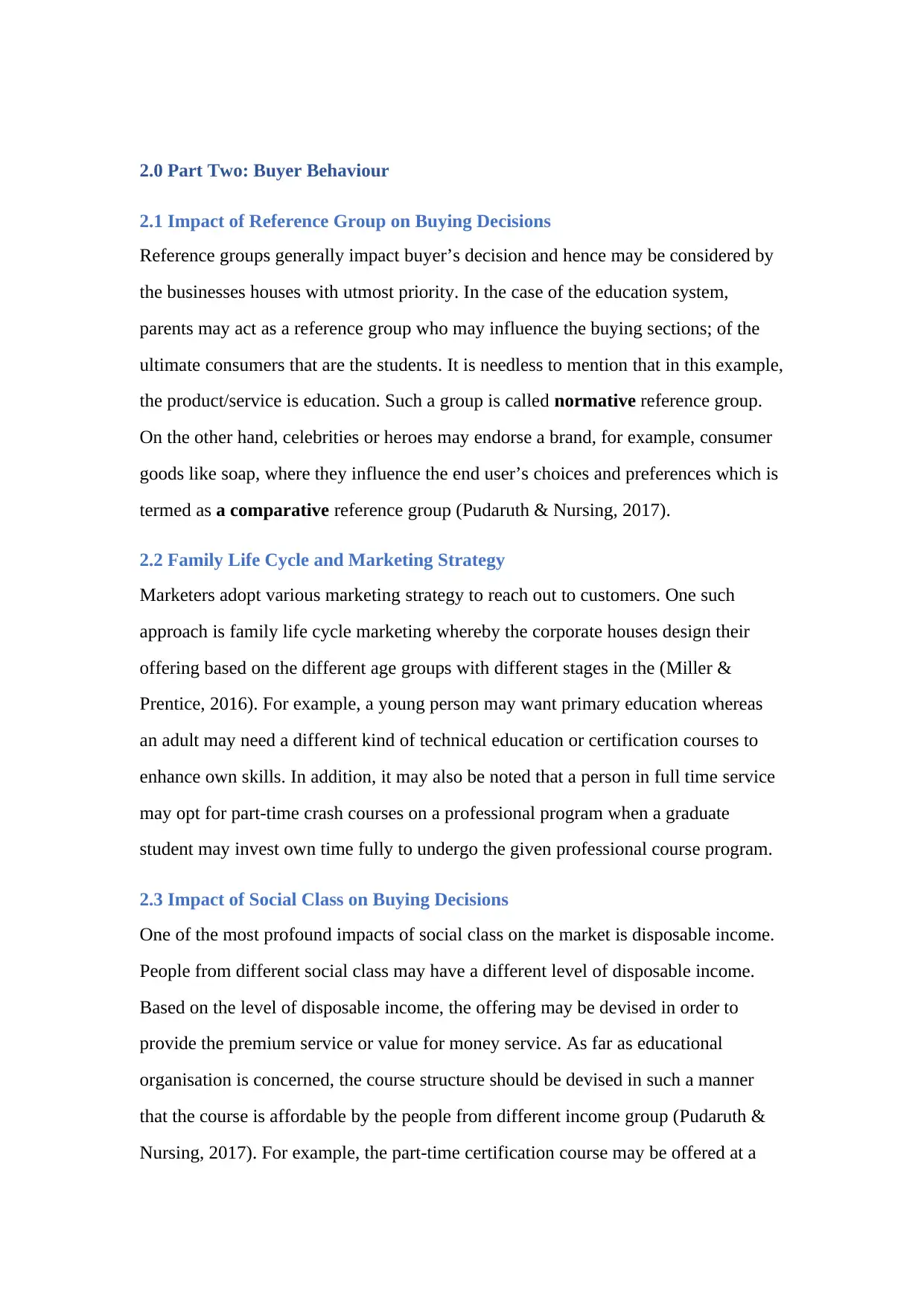
2.0 Part Two: Buyer Behaviour
2.1 Impact of Reference Group on Buying Decisions
Reference groups generally impact buyer’s decision and hence may be considered by
the businesses houses with utmost priority. In the case of the education system,
parents may act as a reference group who may influence the buying sections; of the
ultimate consumers that are the students. It is needless to mention that in this example,
the product/service is education. Such a group is called normative reference group.
On the other hand, celebrities or heroes may endorse a brand, for example, consumer
goods like soap, where they influence the end user’s choices and preferences which is
termed as a comparative reference group (Pudaruth & Nursing, 2017).
2.2 Family Life Cycle and Marketing Strategy
Marketers adopt various marketing strategy to reach out to customers. One such
approach is family life cycle marketing whereby the corporate houses design their
offering based on the different age groups with different stages in the (Miller &
Prentice, 2016). For example, a young person may want primary education whereas
an adult may need a different kind of technical education or certification courses to
enhance own skills. In addition, it may also be noted that a person in full time service
may opt for part-time crash courses on a professional program when a graduate
student may invest own time fully to undergo the given professional course program.
2.3 Impact of Social Class on Buying Decisions
One of the most profound impacts of social class on the market is disposable income.
People from different social class may have a different level of disposable income.
Based on the level of disposable income, the offering may be devised in order to
provide the premium service or value for money service. As far as educational
organisation is concerned, the course structure should be devised in such a manner
that the course is affordable by the people from different income group (Pudaruth &
Nursing, 2017). For example, the part-time certification course may be offered at a
2.1 Impact of Reference Group on Buying Decisions
Reference groups generally impact buyer’s decision and hence may be considered by
the businesses houses with utmost priority. In the case of the education system,
parents may act as a reference group who may influence the buying sections; of the
ultimate consumers that are the students. It is needless to mention that in this example,
the product/service is education. Such a group is called normative reference group.
On the other hand, celebrities or heroes may endorse a brand, for example, consumer
goods like soap, where they influence the end user’s choices and preferences which is
termed as a comparative reference group (Pudaruth & Nursing, 2017).
2.2 Family Life Cycle and Marketing Strategy
Marketers adopt various marketing strategy to reach out to customers. One such
approach is family life cycle marketing whereby the corporate houses design their
offering based on the different age groups with different stages in the (Miller &
Prentice, 2016). For example, a young person may want primary education whereas
an adult may need a different kind of technical education or certification courses to
enhance own skills. In addition, it may also be noted that a person in full time service
may opt for part-time crash courses on a professional program when a graduate
student may invest own time fully to undergo the given professional course program.
2.3 Impact of Social Class on Buying Decisions
One of the most profound impacts of social class on the market is disposable income.
People from different social class may have a different level of disposable income.
Based on the level of disposable income, the offering may be devised in order to
provide the premium service or value for money service. As far as educational
organisation is concerned, the course structure should be devised in such a manner
that the course is affordable by the people from different income group (Pudaruth &
Nursing, 2017). For example, the part-time certification course may be offered at a

higher price as the target customers are earning. On the other hand, the undergraduate
courses may be priced moderately as the students may not have sufficient disposable
income in their hands.
2.4 Impact of Self-Concept on Fashionwear Buying Decisions
Fashion wear is a luxury product where the law of demand does not apply strictly and
hence even if the price of the products goes up, the demand may not go down. In
brief, the demand function for these products is primarily psychological and hence,
the self-concept plays an important role in buying behaviour towards these products
(Johnstone & Tan, 2015). A person with the inclination towards the fashionable
jewellery, for example, will not bother to spend extra amount to get premium products
along with premium services. This is because the person has the pre-decided notion
that the given fashion product will have certain amount of luxury value embedded
within it. However, the business should consider the same while framing its marketing
strategy so that the offering and target group may sync with each other.
2.5 Buyers' Decision-Making Process
The decision-making process is one of the most critical aspects of the study of
consumer behaviour. The process may be viewed from various dimensions such as
sociology, economics and marketing discipline as well. The section below briefly
enumerates the different steps involved in the buyer’s decision-making process.
Stages Activities
Need
recognition
In the first instance, the buyer generates a need to buy something for
own self (Carter & Yeo, 2016). The need may be created either
internally (for example hunger), or externally (for example, word of
mouth, in case of cinema, or a mobile phone etc.).
Personal Example: Personally, I have heard about OPAIC from my
friend and also from reference groups for pursuing higher education.
Information Once the need is generated, the buyer may want to establish the need
courses may be priced moderately as the students may not have sufficient disposable
income in their hands.
2.4 Impact of Self-Concept on Fashionwear Buying Decisions
Fashion wear is a luxury product where the law of demand does not apply strictly and
hence even if the price of the products goes up, the demand may not go down. In
brief, the demand function for these products is primarily psychological and hence,
the self-concept plays an important role in buying behaviour towards these products
(Johnstone & Tan, 2015). A person with the inclination towards the fashionable
jewellery, for example, will not bother to spend extra amount to get premium products
along with premium services. This is because the person has the pre-decided notion
that the given fashion product will have certain amount of luxury value embedded
within it. However, the business should consider the same while framing its marketing
strategy so that the offering and target group may sync with each other.
2.5 Buyers' Decision-Making Process
The decision-making process is one of the most critical aspects of the study of
consumer behaviour. The process may be viewed from various dimensions such as
sociology, economics and marketing discipline as well. The section below briefly
enumerates the different steps involved in the buyer’s decision-making process.
Stages Activities
Need
recognition
In the first instance, the buyer generates a need to buy something for
own self (Carter & Yeo, 2016). The need may be created either
internally (for example hunger), or externally (for example, word of
mouth, in case of cinema, or a mobile phone etc.).
Personal Example: Personally, I have heard about OPAIC from my
friend and also from reference groups for pursuing higher education.
Information Once the need is generated, the buyer may want to establish the need
Paraphrase This Document
Need a fresh take? Get an instant paraphrase of this document with our AI Paraphraser
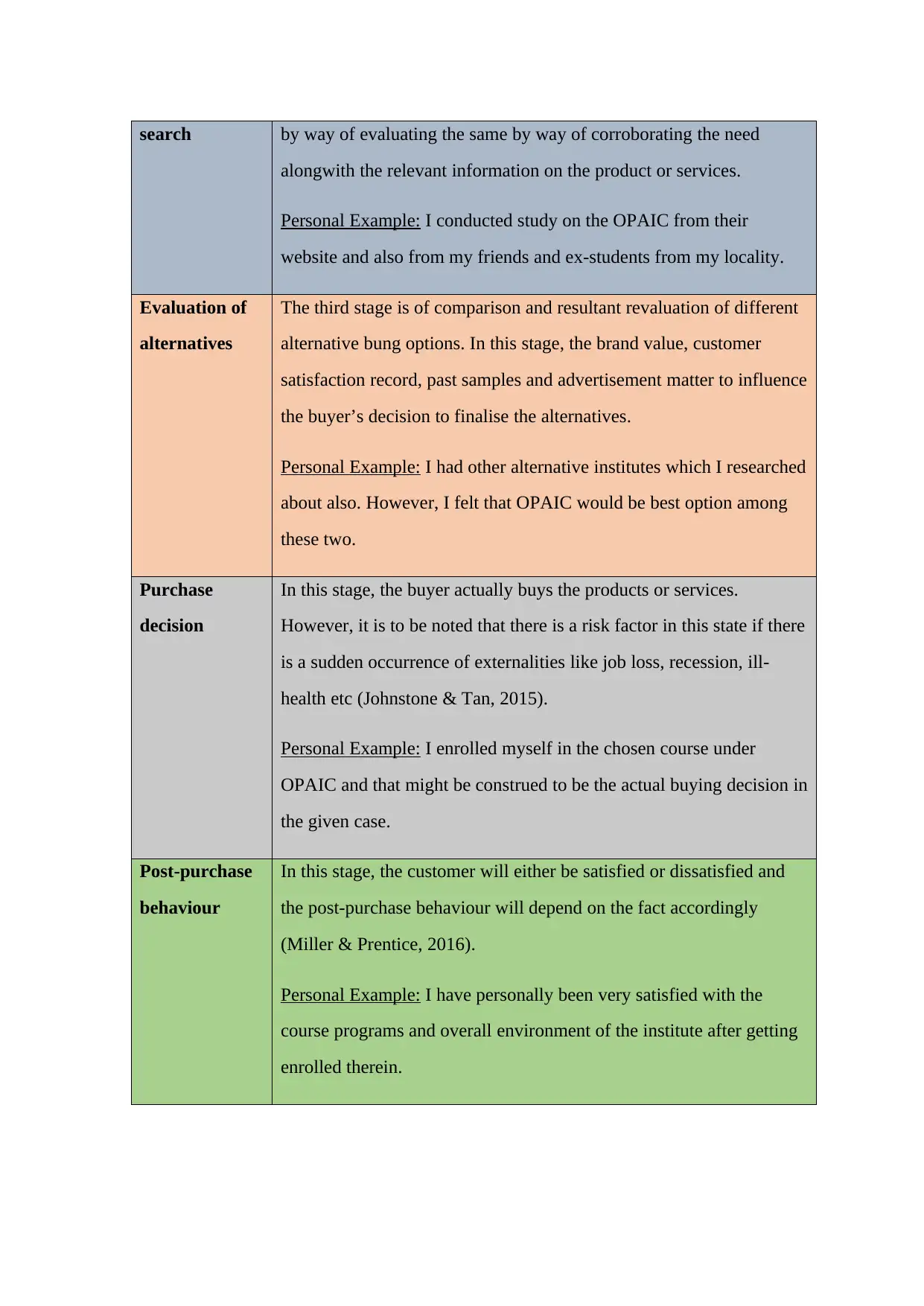
search by way of evaluating the same by way of corroborating the need
alongwith the relevant information on the product or services.
Personal Example: I conducted study on the OPAIC from their
website and also from my friends and ex-students from my locality.
Evaluation of
alternatives
The third stage is of comparison and resultant revaluation of different
alternative bung options. In this stage, the brand value, customer
satisfaction record, past samples and advertisement matter to influence
the buyer’s decision to finalise the alternatives.
Personal Example: I had other alternative institutes which I researched
about also. However, I felt that OPAIC would be best option among
these two.
Purchase
decision
In this stage, the buyer actually buys the products or services.
However, it is to be noted that there is a risk factor in this state if there
is a sudden occurrence of externalities like job loss, recession, ill-
health etc (Johnstone & Tan, 2015).
Personal Example: I enrolled myself in the chosen course under
OPAIC and that might be construed to be the actual buying decision in
the given case.
Post-purchase
behaviour
In this stage, the customer will either be satisfied or dissatisfied and
the post-purchase behaviour will depend on the fact accordingly
(Miller & Prentice, 2016).
Personal Example: I have personally been very satisfied with the
course programs and overall environment of the institute after getting
enrolled therein.
alongwith the relevant information on the product or services.
Personal Example: I conducted study on the OPAIC from their
website and also from my friends and ex-students from my locality.
Evaluation of
alternatives
The third stage is of comparison and resultant revaluation of different
alternative bung options. In this stage, the brand value, customer
satisfaction record, past samples and advertisement matter to influence
the buyer’s decision to finalise the alternatives.
Personal Example: I had other alternative institutes which I researched
about also. However, I felt that OPAIC would be best option among
these two.
Purchase
decision
In this stage, the buyer actually buys the products or services.
However, it is to be noted that there is a risk factor in this state if there
is a sudden occurrence of externalities like job loss, recession, ill-
health etc (Johnstone & Tan, 2015).
Personal Example: I enrolled myself in the chosen course under
OPAIC and that might be construed to be the actual buying decision in
the given case.
Post-purchase
behaviour
In this stage, the customer will either be satisfied or dissatisfied and
the post-purchase behaviour will depend on the fact accordingly
(Miller & Prentice, 2016).
Personal Example: I have personally been very satisfied with the
course programs and overall environment of the institute after getting
enrolled therein.
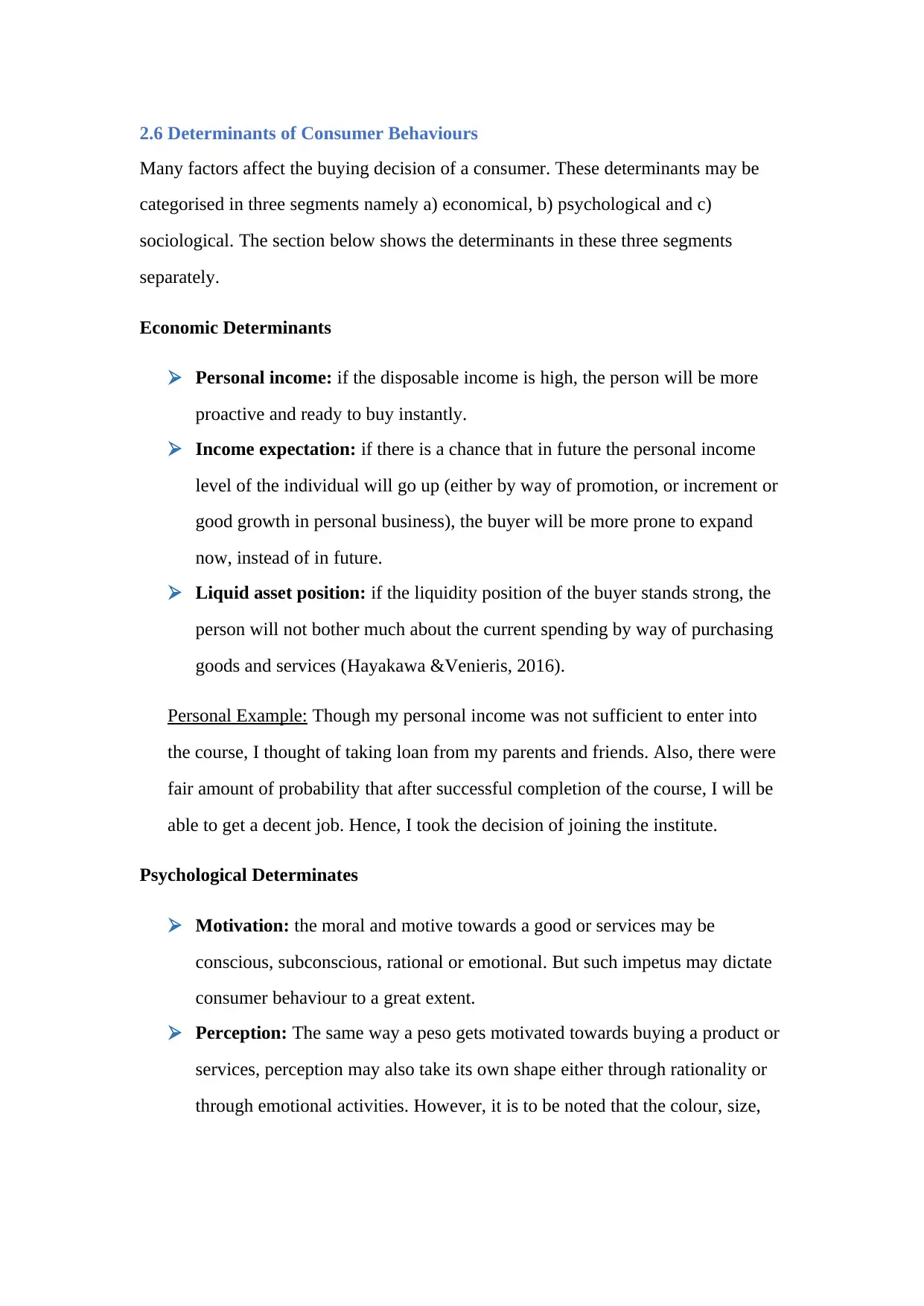
2.6 Determinants of Consumer Behaviours
Many factors affect the buying decision of a consumer. These determinants may be
categorised in three segments namely a) economical, b) psychological and c)
sociological. The section below shows the determinants in these three segments
separately.
Economic Determinants
Personal income: if the disposable income is high, the person will be more
proactive and ready to buy instantly.
Income expectation: if there is a chance that in future the personal income
level of the individual will go up (either by way of promotion, or increment or
good growth in personal business), the buyer will be more prone to expand
now, instead of in future.
Liquid asset position: if the liquidity position of the buyer stands strong, the
person will not bother much about the current spending by way of purchasing
goods and services (Hayakawa &Venieris, 2016).
Personal Example: Though my personal income was not sufficient to enter into
the course, I thought of taking loan from my parents and friends. Also, there were
fair amount of probability that after successful completion of the course, I will be
able to get a decent job. Hence, I took the decision of joining the institute.
Psychological Determinates
Motivation: the moral and motive towards a good or services may be
conscious, subconscious, rational or emotional. But such impetus may dictate
consumer behaviour to a great extent.
Perception: The same way a peso gets motivated towards buying a product or
services, perception may also take its own shape either through rationality or
through emotional activities. However, it is to be noted that the colour, size,
Many factors affect the buying decision of a consumer. These determinants may be
categorised in three segments namely a) economical, b) psychological and c)
sociological. The section below shows the determinants in these three segments
separately.
Economic Determinants
Personal income: if the disposable income is high, the person will be more
proactive and ready to buy instantly.
Income expectation: if there is a chance that in future the personal income
level of the individual will go up (either by way of promotion, or increment or
good growth in personal business), the buyer will be more prone to expand
now, instead of in future.
Liquid asset position: if the liquidity position of the buyer stands strong, the
person will not bother much about the current spending by way of purchasing
goods and services (Hayakawa &Venieris, 2016).
Personal Example: Though my personal income was not sufficient to enter into
the course, I thought of taking loan from my parents and friends. Also, there were
fair amount of probability that after successful completion of the course, I will be
able to get a decent job. Hence, I took the decision of joining the institute.
Psychological Determinates
Motivation: the moral and motive towards a good or services may be
conscious, subconscious, rational or emotional. But such impetus may dictate
consumer behaviour to a great extent.
Perception: The same way a peso gets motivated towards buying a product or
services, perception may also take its own shape either through rationality or
through emotional activities. However, it is to be noted that the colour, size,

brand image, product positioning and targeting may be significant influencers
in creating customer’s perception towards the same.
Attitude and personality: often male customers buy German car as it seems
to be masculine. The personification of the product is a part of typical
consumer behaviour which may be leveraged by the corporate brands
accordingly (Ganiyu, 2017).
Personal Example: Since I was always interested in studying in OPAIC, being one
of the most prominent educational institutes in the region and therefore, the scope
of joining the premium institute aggravated my motivation level to a certain
extent.
Sociological Determinates
As stated previously, the sociological determinants are reference groupslike families,
social class, culture, opinion leaders etc. They exert significant influence on the
individual’s buying habit and therefore convert the person from prospective buyer to
regular buyer.
Personal Example: There was peer pressure, consistent motivation and morale support
by my parents and support groups (friends, family members etc.) to join OPAIC. All
these factors aggravated my demand of higher study in OPAIC.
in creating customer’s perception towards the same.
Attitude and personality: often male customers buy German car as it seems
to be masculine. The personification of the product is a part of typical
consumer behaviour which may be leveraged by the corporate brands
accordingly (Ganiyu, 2017).
Personal Example: Since I was always interested in studying in OPAIC, being one
of the most prominent educational institutes in the region and therefore, the scope
of joining the premium institute aggravated my motivation level to a certain
extent.
Sociological Determinates
As stated previously, the sociological determinants are reference groupslike families,
social class, culture, opinion leaders etc. They exert significant influence on the
individual’s buying habit and therefore convert the person from prospective buyer to
regular buyer.
Personal Example: There was peer pressure, consistent motivation and morale support
by my parents and support groups (friends, family members etc.) to join OPAIC. All
these factors aggravated my demand of higher study in OPAIC.
Secure Best Marks with AI Grader
Need help grading? Try our AI Grader for instant feedback on your assignments.
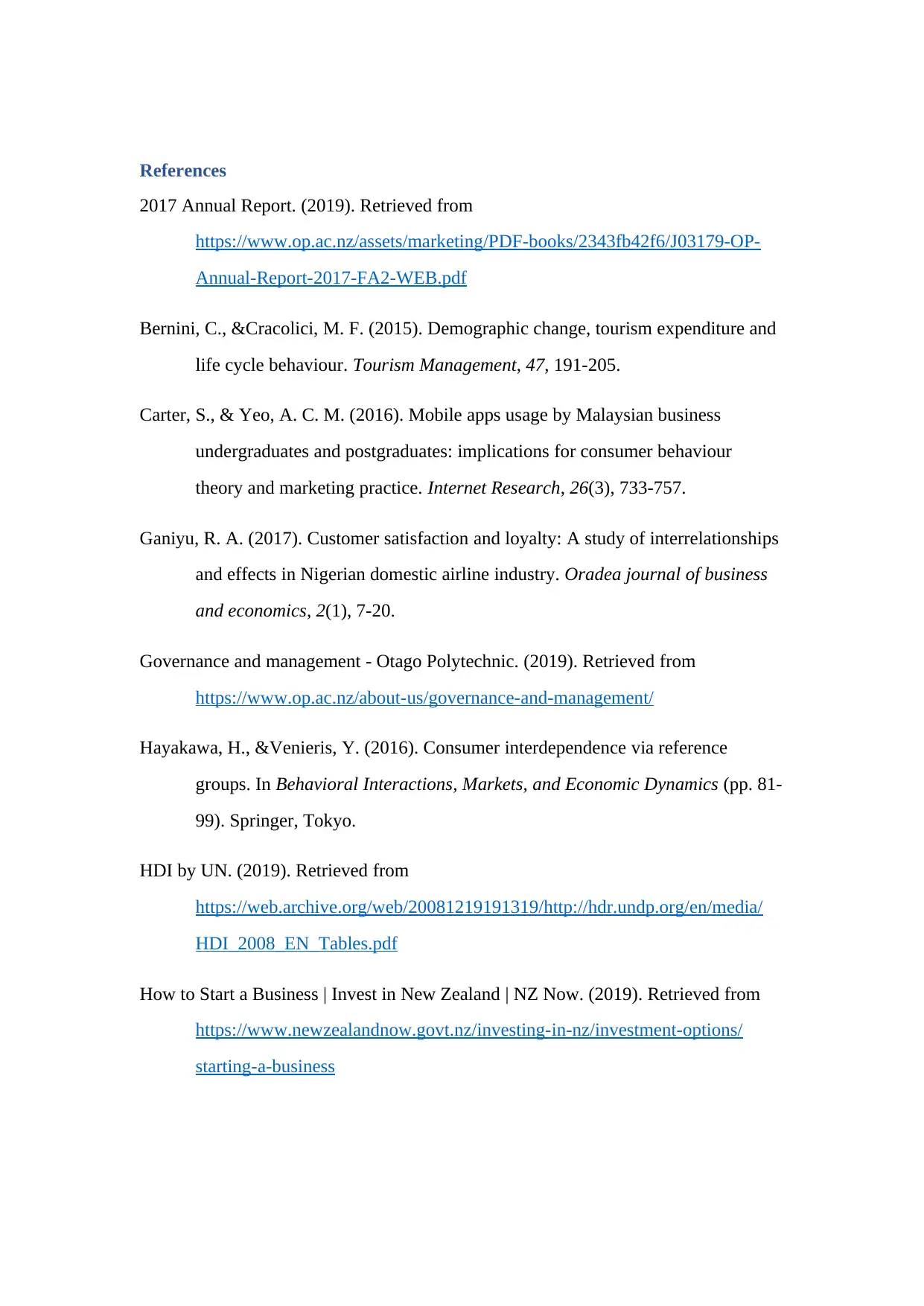
References
2017 Annual Report. (2019). Retrieved from
https://www.op.ac.nz/assets/marketing/PDF-books/2343fb42f6/J03179-OP-
Annual-Report-2017-FA2-WEB.pdf
Bernini, C., &Cracolici, M. F. (2015). Demographic change, tourism expenditure and
life cycle behaviour. Tourism Management, 47, 191-205.
Carter, S., & Yeo, A. C. M. (2016). Mobile apps usage by Malaysian business
undergraduates and postgraduates: implications for consumer behaviour
theory and marketing practice. Internet Research, 26(3), 733-757.
Ganiyu, R. A. (2017). Customer satisfaction and loyalty: A study of interrelationships
and effects in Nigerian domestic airline industry. Oradea journal of business
and economics, 2(1), 7-20.
Governance and management - Otago Polytechnic. (2019). Retrieved from
https://www.op.ac.nz/about-us/governance-and-management/
Hayakawa, H., &Venieris, Y. (2016). Consumer interdependence via reference
groups. In Behavioral Interactions, Markets, and Economic Dynamics (pp. 81-
99). Springer, Tokyo.
HDI by UN. (2019). Retrieved from
https://web.archive.org/web/20081219191319/http://hdr.undp.org/en/media/
HDI_2008_EN_Tables.pdf
How to Start a Business | Invest in New Zealand | NZ Now. (2019). Retrieved from
https://www.newzealandnow.govt.nz/investing-in-nz/investment-options/
starting-a-business
2017 Annual Report. (2019). Retrieved from
https://www.op.ac.nz/assets/marketing/PDF-books/2343fb42f6/J03179-OP-
Annual-Report-2017-FA2-WEB.pdf
Bernini, C., &Cracolici, M. F. (2015). Demographic change, tourism expenditure and
life cycle behaviour. Tourism Management, 47, 191-205.
Carter, S., & Yeo, A. C. M. (2016). Mobile apps usage by Malaysian business
undergraduates and postgraduates: implications for consumer behaviour
theory and marketing practice. Internet Research, 26(3), 733-757.
Ganiyu, R. A. (2017). Customer satisfaction and loyalty: A study of interrelationships
and effects in Nigerian domestic airline industry. Oradea journal of business
and economics, 2(1), 7-20.
Governance and management - Otago Polytechnic. (2019). Retrieved from
https://www.op.ac.nz/about-us/governance-and-management/
Hayakawa, H., &Venieris, Y. (2016). Consumer interdependence via reference
groups. In Behavioral Interactions, Markets, and Economic Dynamics (pp. 81-
99). Springer, Tokyo.
HDI by UN. (2019). Retrieved from
https://web.archive.org/web/20081219191319/http://hdr.undp.org/en/media/
HDI_2008_EN_Tables.pdf
How to Start a Business | Invest in New Zealand | NZ Now. (2019). Retrieved from
https://www.newzealandnow.govt.nz/investing-in-nz/investment-options/
starting-a-business
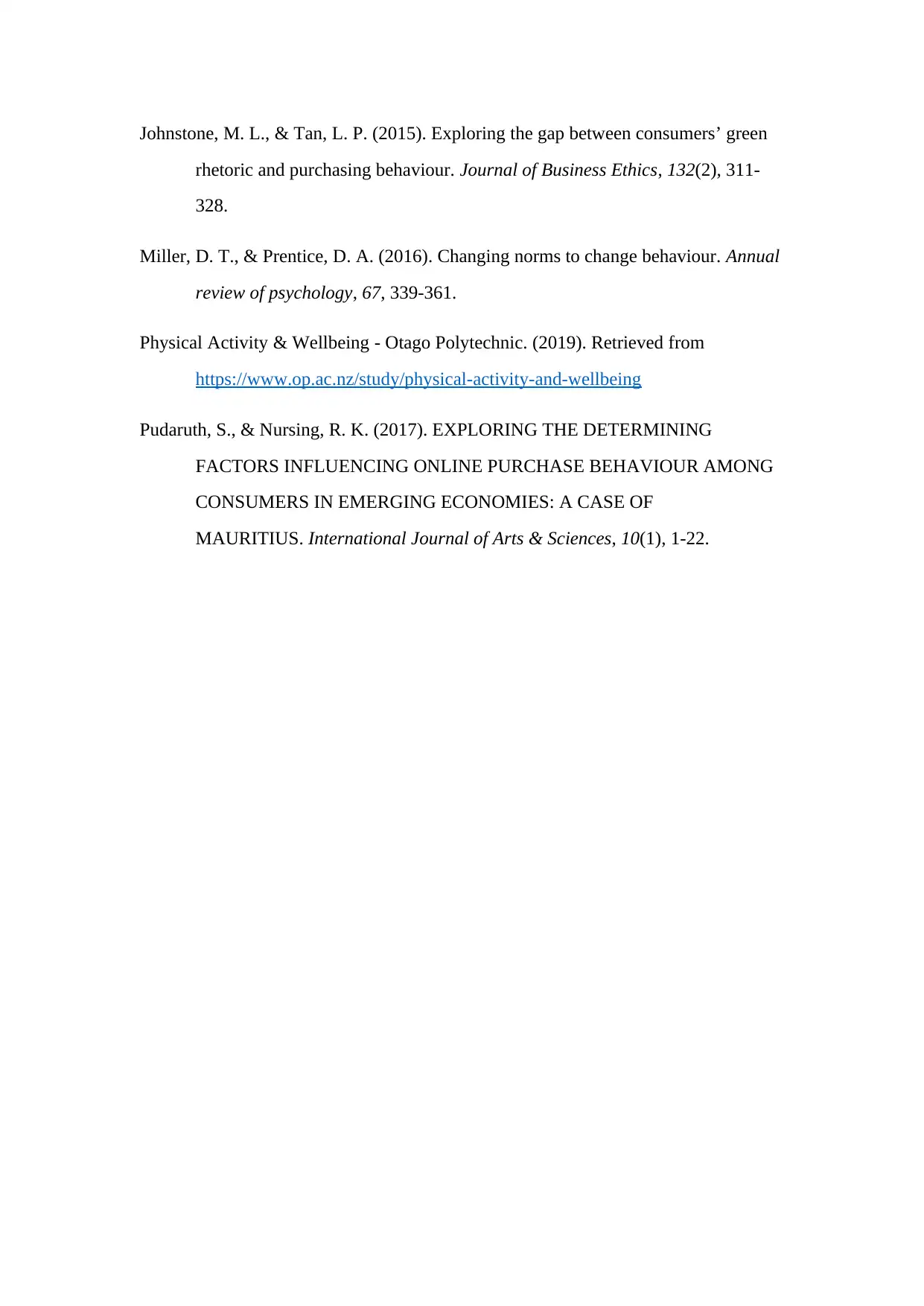
Johnstone, M. L., & Tan, L. P. (2015). Exploring the gap between consumers’ green
rhetoric and purchasing behaviour. Journal of Business Ethics, 132(2), 311-
328.
Miller, D. T., & Prentice, D. A. (2016). Changing norms to change behaviour. Annual
review of psychology, 67, 339-361.
Physical Activity & Wellbeing - Otago Polytechnic. (2019). Retrieved from
https://www.op.ac.nz/study/physical-activity-and-wellbeing
Pudaruth, S., & Nursing, R. K. (2017). EXPLORING THE DETERMINING
FACTORS INFLUENCING ONLINE PURCHASE BEHAVIOUR AMONG
CONSUMERS IN EMERGING ECONOMIES: A CASE OF
MAURITIUS. International Journal of Arts & Sciences, 10(1), 1-22.
rhetoric and purchasing behaviour. Journal of Business Ethics, 132(2), 311-
328.
Miller, D. T., & Prentice, D. A. (2016). Changing norms to change behaviour. Annual
review of psychology, 67, 339-361.
Physical Activity & Wellbeing - Otago Polytechnic. (2019). Retrieved from
https://www.op.ac.nz/study/physical-activity-and-wellbeing
Pudaruth, S., & Nursing, R. K. (2017). EXPLORING THE DETERMINING
FACTORS INFLUENCING ONLINE PURCHASE BEHAVIOUR AMONG
CONSUMERS IN EMERGING ECONOMIES: A CASE OF
MAURITIUS. International Journal of Arts & Sciences, 10(1), 1-22.
1 out of 12
Related Documents
Your All-in-One AI-Powered Toolkit for Academic Success.
+13062052269
info@desklib.com
Available 24*7 on WhatsApp / Email
![[object Object]](/_next/static/media/star-bottom.7253800d.svg)
Unlock your academic potential
© 2024 | Zucol Services PVT LTD | All rights reserved.





